#Miller Center at the University of Virginia
Note
what is the best way to find the full transcripts of speeches by presidents? is there a site that you use for that sort of research?
Yes, there are two particular sites that I tend to use whenever I'm researching speeches or Presidential messages and they are both excellent sources.
The American Presidency Project at the University of California, Santa Barbara is an invaluable resource. The UCSB site has archived hundreds of thousands of speeches, press conference transcripts, messages, and declarations from every President in American history. It's amazing how much information they have available for researchers, and how easy they've made it to navigate the site and find specific speeches or documents. As an example, f you felt like finding the transcripts for the 200+ press conferences that Herbert Hoover did while he was in office, UCSB's American President Project has them ready for your reading pleasure. And they don't just provide easy access to the major speeches that Presidents made while in the White House. You can find transcripts of quick remarks that Presidents made from train platforms during whistle-stop campaigns or radio addresses or signing statements. It's really an indispensable resource for researchers of the Presidency.
The Miller Center at the University of Virginia also has an incredibly useful website with archives of Presidential speeches, but also in-depth essays and features about the Presidency and each of the Presidents. There are extensive oral histories on Presidents dating back to Jimmy Carter, with fascinating insight from scores of people. And the Miller Center has also created a site within their website focusing on the tapes from the White House recording system that eventually helped bring down Richard Nixon. Nixon wasn't the only President who secretly recorded conversations in the White House, and there are tapes available from Franklin D. Roosevelt, Harry Truman, Dwight Eisenhower, John F. Kennedy, and Lyndon B. Johnson, as well as Nixon. Instead of having to search for those recordings at each of those Presidents' respective Presidential Libraries, the Miller Center has made it possible to search their archives for all of those Presidential Recordings. In most cases, they've also helpfully provided transcripts as the tapes are frequently difficult to clearly understand.
Those two sites are pretty much perfect for Presidential history researchers, particularly if you're seeking transcripts of speeches or Presidential messages. I'd also strongly recommend checking out the Presidential Library websites if you're researching someone who has a library. In my opinion, the Presidential Library system is one of the treasures of the National Archives and a treasury of research potential. Almost all of the 15 Presidential Libraries in the network officially maintained and operated by the NARA have extensive research materials that can be accessed online.
#Presidential History#Presidential Speeches#Presidential Research#History#Research#Presidential Studies#American Presidency Project#University of California Santa Barbara#UCSB#Miller Center at the University of Virginia#Miller Center#University of Virginia#Presidency#Presidential Libaries#Presidential Library System#National Archives#National Archives and Records Administration#NARA#White House Tapes#Presidential Recordings
46 notes
·
View notes
Text
Digitized records from wildlife centers show the most common ways that humans harm wild animals
A red-tailed hawk with a broken wing at the New England Wildlife Center in Weymouth, Mass. John Tlumacki/The Boston Globe via Getty Images
by Tara K. Miller, University of Virginia and Richard B. Primack, Boston University
At hundreds of wildlife rehabilitation centers across the U.S., people can learn about wild animals and birds at close range. These sites, which may be run by nonprofits or…

View On WordPress
0 notes
Text
New Ohio County Board of Education Member Selected by State Superintendent

Former Ohio County Board of Education President Erik Schramm been selected to fill the board’s current vacancy.
West Virginia Superintendent of Schools Michele Blatt announced Schramm’s appointment today, and he will likely take part in his first meeting as the newest board member on July 24. He will fill the vacancy left by the passing of board member Grace Norton in May. Schramm lives in Magisterial District 1 which Norton represented.
Ohio County Schools Superintendent Dr. Kimberly Miller thanked Blatt for her thoughtful consideration in the selection, and she looks forward to working with the board’s newest member.
“Mr. Schramm has valuable experience as a past board member and board president,” Miller said. “I anticipate that he will work well with the current board members in working toward the best interest of the students of Ohio County Schools.”
Schramm last served on the board in 2012, and he is the first Wheeling Park High School graduate to serve as Ohio County Board of Education president. He led Ohio County Schools’ first capital campaign for the construction of the J.B. Chambers Performing Arts Center. Schramm and his wife Sharon established the Warwood Middle School Band Scholarship.
Schramm earned a Bachelor of Science Degree in Biology from Bethany College, a Master’s in Business Administration from West Virginia University, a Master’s Certificate in Federal Government Contracting from WVU and the Federal Market Institute and a Juris Doctorate from WVU. He is a partner in the law firm Hanlon, McCormick, Schramm, Bickford & Schramm Co., LPA, located in St. Clairsville, Ohio.
Read the full article
0 notes
Text
Henry Kissinger, War Criminal—Still at Large at 100
We now know a great deal about the crimes he committed while in office, from helping Nixon derail the Paris Peace Talks and prolong the Vietnam War to green-lighting the invasion of Cambodia and Pinochet’s coup in Chile. But we know little about his four decades with Kissinger Associates.
— By Greg Grandin | Published May 15, 2023 | The Nation

Illustration By Steve Brodner
Henry Kissinger should have gone down with the rest of them: Haldeman, Ehrlichman, Mitchell, Dean, and Nixon. His fingerprints were all over Watergate. Yet he survived—largely by playing the press.
Until 1968, Kissinger had been a Nelson Rockefeller Republican—though he also served as an adviser to the State Department in the Johnson administration. Kissinger was stunned by Richard Nixon’s defeat of Rockefeller in the primaries, according to the journalists Marvin and Bernard Kalb. “He wept,” they wrote. Kissinger believed Nixon was “the most dangerous, of all the men running, to have as President.”
It wasn’t long, though, before Kissinger had opened a back channel to Nixon’s people, offering to use his contacts in the Johnson White House to leak information about the peace talks with North Vietnam. Still a Harvard professor, he dealt directly with Nixon’s foreign policy adviser, Richard V. Allen, who in an interview given to the Miller Center at the University of Virginia said that Kissinger, “on his own,” offered to pass along information he had received from an aide attending the peace talks. Allen described Kissinger as acting very cloak-and-dagger, calling him from pay phones and speaking in German to report on what had happened during the talks.
At the end of October, Kissinger told the Nixon campaign, “They’re breaking out the champagne in Paris.” Hours later, President Johnson suspended the bombing. A peace deal might have pushed Hubert Humphrey, who was closing in on Nixon in the polls, over the top. Nixon’s people acted quickly; they urged the South Vietnamese to derail the talks.
Through wiretaps and intercepts, President Johnson learned that Nixon’s campaign was telling the South Vietnamese “to hold on until after the election.” If the White House had gone public with this information, the outrage might also have swung the election to Humphrey. But Johnson hesitated. “This is treason,” he said, as quoted in Ken Hughes’s excellent Chasing Shadows: The Nixon Tapes, the Chennault Affair, and the Origins of Watergate. “It would rock the world.”
Johnson stayed silent. Nixon won. The war went on.
Kissinger, who’d been appointed national security adviser, advised Nixon to order the bombing of Cambodia to pressure Hanoi to return to the negotiating table. Nixon and Kissinger were desperate to resume the talks that they had helped sabotage, and their desperation manifested itself in ferocity. “‘Savage’ was a word that was used again and again” in discussing what needed to be done in Southeast Asia, recalled one of Kissinger’s aides. Bombing Cambodia (a country the US wasn’t at war with), which would eventually break the country and lead to the rise of the Khmer Rouge, was illegal. So it had to be done in secret. The pressure to keep it secret spread paranoia within the administration, leading Kissinger and Nixon to ask J. Edgar Hoover to tap the phones of administration officials. Daniel Ellsberg’s Pentagon Papers leak sent Kissinger into a panic. He was afraid that since Ellsberg had access to the papers, he might also know what Kissinger was doing in Cambodia.
On Monday, June 14, 1971—the day after The New York Times published its first story on the Pentagon Papers—Kissinger exploded, shouting, “This will totally destroy American credibility forever…. It will destroy our ability to conduct foreign policy in confidence…. No foreign government will ever trust us again.”
“Without Henry’s stimulus,” John Ehrlichman wrote in his memoir, Witness to Power, “the president and the rest of us might have concluded that the papers were Lyndon Johnson’s problem, not ours.” Kissinger “fanned Richard Nixon’s flame white hot.”
Why? Kissinger had just begun negotiations with China to reestablish relations and was afraid the scandal might sabotage those talks.
Keying his performance to stir up Nixon’s resentments, he depicted Ellsberg as smart, subversive, promiscuous, perverse—and privileged: “He’s now married a very rich girl,” Kissinger told Nixon.
“They started cranking each other up,” Bob Haldeman remembered (as quoted in Walter Isaacson’s biography of Kissinger), “until they both were in a frenzy.”
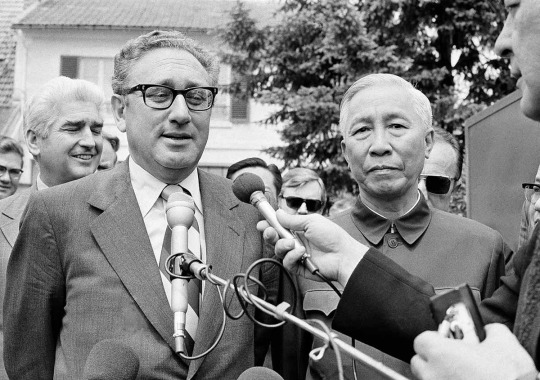
Escape Artist: Though Watergate was as much his doing as Nixon’s, Kissinger emerged unscathed thanks to his admirers in the media. Michel Lipchitz/AP
If Ellsberg gets away unscathed, Kissinger told Nixon, “it shows you’re a weakling, Mr. President,” prompting Nixon to establish the Plumbers—the clandestine unit that conducted buggings and burglaries, including at the Democratic National Committee headquarters at the Watergate Complex.
Seymour Hersh, Bob Woodward, and Carl Bernstein all filed stories fingering Kissinger for the first round of illegal wiretaps—set up by the White House in the spring of 1969 to keep his Cambodia bombing secret.
Landing in Austria en route to the Middle East in June 1974 and finding out that the press had run more unflattering stories and editorials about him, Kissinger held an impromptu press conference and threatened to resign. It was by all accounts a bravura turn. “When the record is written,” he said, seemingly on the verge of tears, “one may remember that perhaps some lives were saved and perhaps some mothers can rest more at ease, but I leave that to history. What I will not leave to history is a discussion of my public honor.”
The gambit worked. He “seemed totally authentic,” New York magazine gushed. As if recoiling from their own sudden doggedness in exposing Nixon’s crimes, reporters and news anchors rallied around Kissinger. While the rest of the White House was revealed as a bunch of two-bit thugs, Kissinger remained someone America could believe in. “We were half-convinced that nothing was beyond the capacity of this remarkable man,” ABC News’ Ted Koppel said in a 1974 documentary, describing Kissinger as “the most admired man in America.” He was, Koppel added, “the best thing we’ve got going for us.”
We now know much more about Kissinger’s other crimes, the immense suffering he caused during his years in public office. He green-lighted coups and enabled genocides. He told dictators to get their killing and torturing done quickly, sold out the Kurds, and ran the botched operation to kidnap Chilean Gen. René Schneider (in the hope of derailing President Salvador Allende’s inauguration), which resulted in Schneider’s murder. His post-Vietnam turn to the Middle East left that region in chaos, setting the stage for crises that continue to afflict humanity.
We know little, though, about what came later, during his four decades of work with Kissinger Associates. The firm’s “client list” has been one of the most sought-after documents in Washington since at least 1989, when Senator Jesse Helms unsuccessfully demanded to see it before he would consider confirming Lawrence Eagleburger (a Kissinger protégé and an employee of Kissinger Associates) as deputy secretary of state. Later, Kissinger quit as chair of the 9/11 Commission rather than hand over the list for public review.
Kissinger Associates was an early player in the wave of privatizations that took place after the end of the Cold War—in the former Soviet Union, Eastern Europe, and Latin America—helping to create a new international oligarchic class. Kissinger had used the contacts he made as a public official to found one of the most lucrative firms in the world. Then, having escaped the taint of Watergate, he used his reputation as a foreign policy sage to influence public debate—to the benefit, we can assume, of his clients. Kissinger was an eager advocate of both Gulf Wars, and he worked closely with President Clinton to push NAFTA through Congress.
The firm also made book on policies put into place by Kissinger. In 1975, as secretary of state, Kissinger helped Union Carbide set up its chemical plant in Bhopal—working with the Indian government and securing funds from the United States. After the plant’s 1984 chemical leak disaster, Kissinger Associates represented Union Carbide, brokering a paltry out-of-court settlement for the victims of the leak, which caused nearly 4,000 immediate deaths and exposed another half-million people to toxic gases.
A few years ago, much fanfare attended Kissinger’s donation of his public papers to Yale. But we’ll never know most of what his firm has been up to in Russia, China, India, the Middle East, and elsewhere. He’ll take those secrets with him when he goes.
— Greg Grandin, a Nation editorial board member, is the Peter V. and C. Vann Woodward Professor of History at Yale University and author of The End of the Myth, winner of the 2020 Pulitzer Prize for general nonfiction.
0 notes
Text
Richardson, TX, is a University Town
The university is situated in Richardson, Texas. Some individuals enjoy the location, while others do not. Richardson is a college town, which contributes to some traffic. However, this may be a minor concern if you appreciate the college atmosphere. Overall, the advantages of residing here outweigh the disadvantages. This can be a great town if you are considering relocating to Richardson, Texas. I'm sure you'll find a perfect home that matches your requirements. If you have house blessings, it will help you prepare for your event if you get a caterer in Richardson, TX, that will prepare the food for you, your family, and your guests. Or if you have an upcoming party or celebration, this caterer can help you.
Caterer in Richardson, TX
Hiring a catering service provide access to high-quality ingredients and wider menu options. The best caterer in Richardson, TX, is Naborly Provisions Catering. It stands out from the competition with its focus on hospitality in a Naborly way. Founder Krista Nabors Dick has over ten years of experience in the industry and has created a catering company that provides delectable food, impeccable service, and a boutique-style menu. Naborly Provisions Catering offers transparent pricing and flexibility to accommodate dietary restrictions or specific menu requests, and its friendly and professional staff is dedicated to ensuring your event is a success. Contact them now to plan your successful event at 469-677-7004 EXT 1.

Catering Food and Drink Supplier
You can trust Naborly Provisions Catering, the well-known catering food and drink supplier, to make your event a success and give your guests a memorable experience. The professional staff takes care of everything for you, so you can sit back and relax. This seasoned caterer delivers impeccable service and makes your event a success. So, if you are looking for a caterer that provides exceptional service, Naborly Provisions Catering has you covered. Their friendly and professional staff work hard to ensure your guests have an unforgettable experience. With its expertise in various cuisines and unique Texas hospitality, Naborly Provisions Catering is the ideal choice for any event. It's the go-to caterer for delivering delectable food, impeccable service, and a simplistic approach that will impress your clients, industry partners, and community. For inquiries, call 469-677-7004 EXT 1.
Charles W. Eisemann Center for Performing Arts
The Charles W. Eisemann Center for Performing Arts and Corporate Presentations is located in the Galatyn Park Urban Center in Richardson's business and technology area. Its main lobby, Ticket Office, Forrest & Virginia Green Mezzanine Gallery, and administrative office are open to the public from 10 am to 6 pm, Monday to Saturday. This center aims to promote cultural diversity, educational enrichment, and fulfilling experiences for everyone in the community. Since its opening in September 2002, they have become a top-performing arts facility in the Dallas/Fort Worth area, recognized by clients, patrons, and the media for its events and architectural design.
Richardson Man Enters a Guilty plea for Multiple Charges
A man from Richardson has pled guilty to nine of the 13 charges he faced concerning the Capitol insurrection that occurred on January 6, 2021. Garret Miller, aged 36, was accused of storming the U.S. Capitol building and threatening Democratic lawmaker Alexandria Ocasio-Cortez on social media. He was arrested in the weeks following the incident and charged with multiple felony and misdemeanor charges. According to a federal complaint, Miller shared videos on social media showing himself inside the Capitol building during the riots. Before the event, Miller created Facebook posts indicating he would attend a pro-Donald Trump rally in Washington, D.C., and bring weapons. Read more.
Link to maps
Charles W. Eisemann Center for Performing Arts and Corporate Presentations
2351 Performance Dr, Richardson, TX 75082, United States
Get on N Central Expy in Dallas County from Galatyn Pkwy
2 min (0.6 mi)
Take US-75 S to W Tyler St
3 min (2.4 mi)
Continue on W Tyler St to your destination
52 sec (0.1 mi)
Naborly Provisions Catering
514 Lockwood Dr, Richardson, TX 75080, USA
1 note
·
View note
Photo
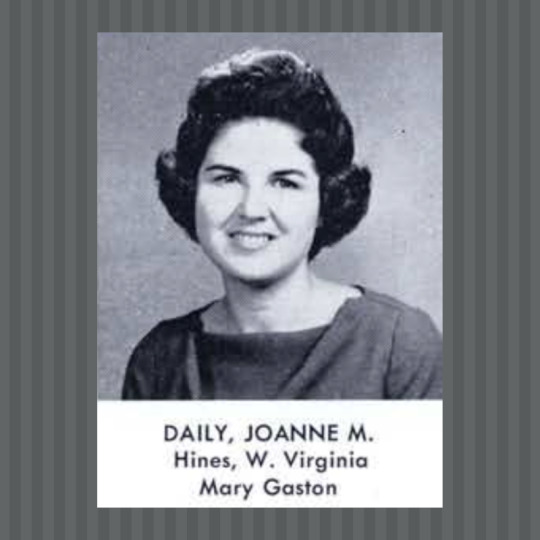
Joanne Marie (Daily) Livesay, 79, of Lewisburg passed away Monday morning April 4, 2022 at Greenbrier Health Care Center in Fairlea.
She was born February 10, 1943 in Hines, WV and was the daughter of the late Paul C. and Lola (Johnson) Daily, Sr.
Joanne was a member of the Greenbrier Valley Church of the Nazarene. She was dedicated to the teaching and instruction of young children and youth. Joanne held a Bachelor of Science degree in Education with teaching majors in English and Social Studies from Bob Jones University. She also had a Masters of Arts degree in Education specialization in Reading instruction from Appalachian State University. Additionally, she completed post Masters degree graduate work at Marshall Graduate College of Marshall University, Radford University and West Virginia College of Graduate Studies , completing additional certifications in Principalship, Supervision of Instruction and other administrative categories. Joanne loved religious music and the scriptures. She had a heart of genuine respect and love of humanity.
Other than her parents, she was preceded in death by brothers Paul C. Daily, Jr., Rev. Robert Daily and Rick Daily.
Joanne leaves her husband Dr. Dwight Livesay; son Michael P. Livesay and his wife Kelli Anne of Denver, Co.; granddaughter Eliza Romero-Cahonne; brothers Rev. James Daily of Mobile, AL and Michael Daily of Williamsburg, WV; nine nephews and eight nieces.
Funeral services for Joanne are scheduled for Monday April 11, 2022 at 2:00 PM at The First Baptist Church of Fairlea with Pastor Ron Miller officiating.
Expressions of sympathy may be made to Anne Edwards Scholarship; 9146 Seneca Trail South, Ronceverte, WV 24970.
#Bob Jones University#Archive#Obituary#BJU Hall of Fame#BJU Alumni Association#2022#Joanne Marie (Daily) Livesay#Class of 1964
0 notes
Text
New undergraduate nursing scholarship established through Heather Miller Memorial Golf Classic | School of Nursing
New undergraduate nursing scholarship established through Heather Miller Memorial Golf Classic | School of Nursing
Participants with CORE (Center for Organ Recovery and Education) pose for a photo at the 15th annual Heather Miller Memorial Golf Classic.
The Heather Miller Memorial Golf Classic, which recognized its 15th year on July 29, had already established two fully endowed scholarships for the West Virginia University School of Nursing — one undergraduate and one graduate level. Thanks to this year’s…

View On WordPress
0 notes
Text
Three Common Types of Orthopedic Surgeries

Bobby Chhabra is an orthopedic hand surgeon at the University of Virginia (UVA) Orthopedics Center, where he serves as a professor and chair of orthopedic surgery. In 2006, Bobby Chhabra was awarded best lecturer for the Miller Orthopedic Board Review Course.
Orthopedic surgeries are surgeries that intend to repair the musculoskeletal system. The musculoskeletal system refers to the different parts of the body ranging from joints, ligaments, tendons, nerves, bones, and muscles. This means that an orthopedic doctor is responsible for treating broken bones, torn tendons, nerve injuries, and muscle injuries. Depending on the patient's condition, orthopedic surgeons perform different types of surgeries.
As its name implies, revision joint surgery is a type of surgery that revises or corrects defective implants. The old implant is removed and replaced with a new one with this procedure, hence the name.
Further, joint replacement procedures are arguably the most common type of orthopedic surgery. This type of orthopedic procedure involves the replacement of damaged joints with prosthetic ones. Spinal fusion is another common type of orthopedic surgery that repairs or stabilizes a damaged or arthritic spine by fusing or joining different vertebrae.
0 notes
Photo

Today we remember the passing of Daniel Johnston who Died: September 11, 2019 in Waller, Texas
Daniel Dale Johnston (January 22, 1961 – c. September 11, 2019) was an American singer-songwriter and visual artist regarded as a significant figure in outsider, lo-fi, and alternative music scenes. Most of his work consisted of cassettes recorded alone in his home, and his music was frequently cited for its "pure" and "childlike" qualities.
Johnston spent extended periods in psychiatric institutions and was diagnosed with bipolar disorder. He gathered a local following in the 1980s by passing out tapes of his music while working at a McDonald's in Dobie Center in Austin, Texas. His cult status was propelled when Nirvana's Kurt Cobain was seen wearing a T-shirt that featured artwork from Johnston's 1983 cassette album Hi, How Are You.
Beyond music, Johnston was accomplished as a visual artist, with his illustrations exhibited at various galleries around the world. His struggles with mental illness were the subject of the 2005 documentary The Devil and Daniel Johnston. He died in 2019 of what is suspected to have been a heart attack.
Johnston was born in Sacramento, California, and grew up in New Cumberland, West Virginia. He was the youngest of five children of William Dale "Bill" Johnston (1922–2017) and Mabel Ruth Voyles Johnston (1923–2010). He began recording music in the late 1970s on a $59 Sanyo monaural boombox, singing and playing piano as well as the chord organ. Following graduation from Oak Glen High School, Johnston spent a few weeks at Abilene Christian University in West Texas before dropping out. He later attended the art program at Kent State University, East Liverpool, during which he recorded Songs of Pain and More Songs of Pain.
When Johnston moved to Austin, Texas, he began to attract the attention of the local press and gained a following augmented in numbers by his habit of handing out tapes to people he met. Live performances were well-attended and hotly anticipated. His local standing led to him being featured in a 1985 episode of the MTV program The Cutting Edge featuring performers from Austin's "New Sincerity" music scene.
In 1988, Johnston visited New York City and recorded 1990 with producer Mark Kramer at his Noise New York studio. This was Johnston's first experience in a professional recording environment after a decade of releasing home-made cassette recordings. His mental health further deteriorated during the making of 1990. In 1989, Johnston released the album It's Spooky in collaboration with singer Jad Fair of the band Half Japanese.
In 1990, Johnston played at a music festival in Austin, Texas. On the way back to West Virginia on a private two-seater plane piloted by his father Bill, Johnston had a manic psychotic episode; believing he was Casper the Friendly Ghost, Johnston removed the key from the plane's ignition and threw it outside. His father, a former U.S. Air Force pilot, managed to successfully crash-land the plane, even though "there was nothing down there but trees". Although the plane was destroyed, Johnston and his father emerged with only minor injuries. As a result of this episode, Johnston was involuntarily committed to a mental hospital.
Interest in Johnston increased when Kurt Cobain was frequently photographed wearing a T-shirt featuring the cover image of Johnston's album Hi, How Are You that music journalist Everett True gave him. Cobain listed Yip/Jump Music as one of his favorite albums in his journal in 1993. In spite of Johnston being resident in a mental hospital at the time, there was a bidding war to sign him. He refused to sign a multi-album deal with Elektra Records because Metallica was on the label's roster and he was convinced that they were Satanic and would hurt him, also dropping his longtime manager, Jeff Tartakov, in the process. Ultimately he signed with Atlantic Records in February 1994 and that September released Fun, produced by Paul Leary of Butthole Surfers. It was a commercial failure. In June 1996, Atlantic dropped Johnston from the label.
In 1993, the Sound Exchange record store in Austin, Texas, commissioned Johnston to paint a mural of the Hi, How Are You? frog (also known as "Jeremiah the Innocent") from the album's cover. After the record store closed in 2003, the building remained unoccupied until 2004 when the Mexican grill franchise Baja Fresh took ownership and decided that they would remove the wall that held the mural. A group of people who lived in the neighborhood convinced the managers and contractors to keep the mural intact. In 2018, the building housed a Thai restaurant called "Thai, How Are You". Thai How Are You permanently closed in January 2020. The building remains empty
In 2004, he released The Late Great Daniel Johnston: Discovered Covered, a two-disc compilation. The first disc featured covers of his songs by artists including Tom Waits, Beck, TV on the Radio, Jad Fair, Eels, Bright Eyes, Calvin Johnson, Death Cab for Cutie, Sparklehorse, Mercury Rev, The Flaming Lips and Starlight Mints, with the second disc featuring Johnston's original recordings of the songs. In 2005, Texas-based theater company Infernal Bridegroom Productions received a Multi-Arts Production/MAP Fund grant to work with Johnston to create a rock opera based on his music, titled Speeding Motorcycle.
In 2006, Jeff Feuerzeig released a documentary about Johnston, The Devil and Daniel Johnston; the film, four years in the making, collated some of the vast amount of recorded material Johnston (and in some case, others) had produced over the years to portray his life and music. The film won high praise, receiving the Director's Award at the 2005 Sundance Film Festival. The film also inspired more interest in Johnston's work, and increased his prestige as a touring artist. In 2006, Johnston's label, Eternal Yip Eye Music, released his first greatest-hits compilation, Welcome to My World.
Through the next few years Johnston toured extensively across the world, and continued to attract press attention. His artwork was shown in galleries such as in London's Aquarium Gallery, New York's Clementine Gallery and at the Liverpool Biennial in 2006 and 2008, and in 2009, his work was exhibited at "The Museum of Love" at Verge Gallery in Sacramento, California. In 2008, Dick Johnston, Johnston's brother and manager, revealed that "a movie deal based on the artist's life and music had been finalized with a tentative 2011 release." He also said that a deal had been struck with the Converse company for a "signature series" Daniel Johnston shoe. Later, it was revealed by Dick Johnston that Converse had dropped the plan. In early 2008, a Jeremiah the Innocent collectible figurine was released in limited runs of four different colors. Later in the year, Adjustable Productions released Johnston's first concert DVD, The Angel and Daniel Johnston – Live at the Union Chapel, featuring a 2007 appearance in Islington, London.
Is and Always Was was released on October 6, 2009, on Eternal Yip Eye Music. In 2009, it was announced that Matt Groening had chosen Johnston to perform at the edition of the All Tomorrow's Parties festival that he curated in May 2010, in Minehead, England. Also that year, Dr. Fun Fun and Smashing Studios developed an iPhone platform game called Hi, How Are You. The game is similar to Frogger, but features Johnston's art and music. Johnston played it during its development and liked it, although he was not familiar with the iPhone.
On March 13, 2012, Johnston released his first comic book, Space Ducks – An Infinite Comic Book of Musical Greatness at SXSW, published by BOOM! Studios. The comic book ties-in with the Space Ducks album and an iOS app. Johnston collaborated with skateboarding and clothing company Supreme on numerous collections (consisting of clothing and various accessories) showcasing his artwork.
On March 1, 2012, Brooklyn-based photographer Jung Kim announced her photo book and traveling exhibition project with Johnston titled DANIEL JOHNSTON: here, a collaboration that began in 2008 when Kim first met Johnston and began photographing him on the road and at his home in Waller, Texas. On March 13, 2013, this photography book was published, featuring five years of documentation on Johnston. The opening exhibition at SXSW festival featured a special performance by Johnston along with tribute performances led by Jason Sebastian Russo formerly of Mercury Rev. The second exhibition ran in May and June 2013 in London, England, and featured a special performance by Johnston along with tribute performances by the UK band Charlie Boyer and the Voyeurs with Steffan Halperin of the Klaxons. On October 10, 2013, Jason Pierce of Spiritualized hosted the New York City opening of the exhibition, which included special tribute performances led by Pierce and Glen Hansard of The Swell Season and The Frames.
In November 2015, Hi, How Are You Daniel Johnston?, a short documentary about Johnston's life, was released featuring Johnston as his 2015 self and Gabriel Sunday of Archie's Final Project as Johnston's 1983 self. The executive producers for the film included Lana Del Rey and Mac Miller.
In July 2017, Johnston announced that he would be retiring from live performance and would embark on a final five-date tour that fall. Each stop on the tour featured Johnston backed by a group that had been influenced by his music: The Preservation All-Stars in New Orleans, The Districts and Modern Baseball in Philadelphia, Jeff Tweedy in Chicago, and Built to Spill for the final two dates in Portland and Vancouver.
On September 11, 2019, Johnston was found dead from a suspected heart attack at his home in Waller, Texas, a day after he was released from the hospital for unspecified kidney problems. It is believed that he died overnight.
14 notes
·
View notes
Text
vimeo
Here's the phone call between Lady Bird Johnson and LBJ from March 7, 1964 where Lady Bird is reviewing President Johnson's performance at a televised press conference, showing a very different side of both Lady Bird and LBJ, as mentioned in my last post.
This is from the LBJ Library's awesome LBJ Tapes website, created in conjunction with the University of Virginia's Miller Center, which specializes in Presidential history. The LBJ Tapes website features an archive of audio and transcripts of LBJ's taped phone calls that you can search or browse through depending on details such as the topic of conversation, date of the phone call, or names of the participants of the calls (which include people like Lady Bird, Martin Luther King Jr., Jacqueline Kennedy, Gerald Ford, Robert F. Kennedy, Ted Kennedy, Dwight D. Eisenhower, Harry S. Truman, Richard Nixon, Hubert Humphrey, and scores of other important historical figures).
You can really spend days exploring the LBJ Tapes website, and some of the more fascinating topics like LBJ's calls in the hours and days following JFK's assassination where he's becoming more comfortable in the Presidency and begins asking (and, in some cases, ordering) people to serve on the Warren Commission, or LBJ's behind-the-scenes machinations during the 1968 Presidential campaign, as MLK and then RFK are assassinated, the 1968 Chicago Democratic Convention spins out of control and Richard Nixon's campaign makes some shady moves with the Vietnamese to help ensure their own victory. On all of these calls, you hear the real Lyndon B. Johnson and they give an eye-opening definition to the "Johnson Treatment".
#LBJ Tapes#History#Politics#Presidents#Presidential Politics#Presidential History#Lyndon B. Johnson#Lyndon Johnson#President Johnson#LBJ#LBJ Library#White House Tapes#Lady Bird Johnson#Miller Center#University of Virginia#Political History#Presidential Elections#1968 Election#1968 Democratic National Convention#Chicago Seven#JFK Assassination#Kennedy Assassination#Warre Commission#Richard Nixon#Martin Luther King Jr.#MLK#Robert F. Kennedy#RFK#Johnson Treatment#Gerald Ford
8 notes
·
View notes
Text
The Slaw Line, Fallout 76 and Other Stories We Need to Tell About West Virginia
(Publisher's Note: This article was published late last week on Moundsville.org, and with permission of the publisher, John W. Miller, we're re-publishing it this morning in case LEDE News readers missed it on the Marshall County blog.)
West Virginia might be the most misunderstood state in the union. How can outsiders, and its own people, understand it better?
The best answer, of course, is to empower and celebrate storytellers from West Virginia — like memoirist Neema Avashia, or Steve Novotney in Wheeling, WV and Brianna Hickman in Moundsville – who write about their home communities.
Emily Hilliard, the state’s folklorist from 2015-2021, has written Making Our Future (UNC Press, 312 p., $24.95), a rich, witty, deeply-reported and impassioned survey of West Virginia folklife, and a plea for “collaborative ethnography”.
That’s a way of reporting “in a place like Appalachia, where journalists and cultural workers have extracted stories and cultural resources without community input, benefit, or respect, employing narratives that frame the region’s faults as individual failures rather than systemic problems.”
For her kinder, more human approach, amplified by a relentless and refreshing curiosity, Hilliard chose eight specific stories: the history of the Scotts Run coal-mining community and its museum; the inspiring, heart-melting songwriting of four working-class women; the food and culture of Helvetia, WV, a Swiss community of 59 people; the landscape of the stories of legendary fiction writer Breece D’J Pancake in Milton, WV; the West Virginia teachers’ strike; hotdogs and the so-called “slaw line”, which demarcates where coleslaw is added; independent pro wrestling; and the video game Fallout 76.
The nature of her work as a public folklorist, she writes, “is to offer my assistance to local communities in recognizing themselves as collectivities with some shared identity and history (even if contested), communities that, through shared reactive expression, can together realize the power of self-determination in making their future.” (As University of Pittsburgh anthropologist Loukas Barton told me after we premiered our oral history film Moundsville in the town’s it’s about: Presenting a finished work to the subject “is about respect, but it’s also aboutinteraction, collaboration and growth. Self-knowledge can give a community political power.”
When Hilliard moved to West Virginia from Washington, DC on Halloween, 2015, she discovered a wildly diverse state.
Today there are still actively practiced African American, Serbian, Lebanese, Italian, Spanish, Swiss, Greek, and Polish traditions…West Virginia is also home to newer Syrian, Haitian, and Burmese refugees, and a quickly growing Latinx population. A new Hindu temple opened in Dunbar in 2017, and the Islamic Center in Charleston, a multiracial and multiethnic faith community, has over 400 active members. It is important to note that while West Virginia is declining in population overall, notably among its white population, communities of color in the state are growing.
One of West Virginia’s most expansive exposures in the last decade has been the best-selling video game, Fallout 76, which takes place in post-apocalyptic West Virginia, 25 years after a nuclear war has decimated the world. Players emerge from a bunker in Flatwoods, WV, and are charged with fighting two-headed opossums, giant ticks and mangy beavers, and the Scorched, a zombie-like army, securing nuclear silos and making the world for rebuilding and repopulating.
Rightly, Hilliard spends an essay exploring the game’s cultural significance. It is, after all, global. She quotes Norwegian Anders Isaken: “I have been playing Fallout 76 and I have to admit that I have developed a love for West Virginia. I have never been to the USA but if I were ever to get a chance to visit your wonderful country West Virginia is high on my list of places I want to travel to. Your local culture, folklore, nature and people seem absolutely lovely. Without the game you and your amazing state would just be a word on a map. Now it is in my heart. Country Roads take me home.”
The game is full of West Virginia tourist sites, including Harper’s Ferry, the Mothman Museum, the Moundsville prison, New Vrindaban, and the Greenbrier resort. “The in-game portrayal of Helvetia, the remote mountain village of population 59, founded in 1869 by Swiss German immigrants, is particularly accurate,” Hilliard reports. “Though the game designers swapped a few building locations, the scale and aesthetic is impeccably simulated and everything is there, down to the hand-painted signs, the historic bootmaker shack, Cheese Haus, Honey Haus, Hutte Swiss Restaurant (called Freya’s Restaurant in-game), the Kultur Haus/general store/post office, mask museum, and even the assortment of instruments in the museum that belonged to the original members of the real Helvetia Star Band. Though I never played the game, when I watched a friend navigate through virtual Helvetia, I was able to direct him to where to go based on my familiarity with the town.”
The world of Fallout 76 “is a West Virginia that has been returned to the frontier it once was.”
Fallout 76, is also an example of extracting a cultural resource, and could possibly overwhelm the tourist capacities of small towns. It’s also expensive and difficult to play for people without decent incomes and good broadband. Hilliard argues that “as a next step beyond documentation, contextualization, and presentation, folklorists, myself included, should be more attuned to the future life of traditions beyond sustainability, and actively work in collaboration with communities to combat the outside destructive forces, such as privatization, extraction, and austerity, that disrupt them and block their agency to negotiate the transmission of their traditions.”
The book shines brightest when Hilliard is on the ground:
Leaving Charleston and heading southeast, the road is immediately hedged in between the mountains on the left and the Kanawha River on the right, with the railroad crossing back and forth over the course of the journey. In Malden, I pass the former location of the saltworks where Booker T. Washington worked as a boy. In belle, smokestacks and cranes stretch up into the sky, competing with the mountains for the view. A group of Black girls with new glittery pink bikes ride by a group of white girls holding signs advertising a yard sale. I drive past cinderblock auto shops and neat former company houses and churches (so many churches!)—Church of Christ, Church of God, Catholic, African Zion Baptist, First Baptist, Memorial Baptist, and the mysterious “House of Non-Judgement.” There’s an old three-story brick elementary school, Dollar Generals, and a barbecue restaurant, a couple Taco Bells, the beloved West Virginia chain Turdor’s Biscuit World, and a Shoney’s Buffet with a sign that reads “Reopening Soon.” Past Cedar Grove, hand-painted boards advertising a hot dog joint are stapled to telephone poles every few yards and campaign signs are scattered along the berm. In London, the transport system for the Mammoth Coal Processing Plant arches from the hillside over the road to a looming metal tipple, standing guard.
The book’s title comes from a conversation Hilliard reports with a high school student while covering the West Virginia teachers' strike. She also quotes the poet Audre Lorde: “We are making the future as well as bonding to survive the enormous pressures of the present, and that is what it means to be part of history.”
However West Virginia makes its future, I pray for more of what Hilliard lovingly demonstrates: encounters with neighbors close and far, not judging, just listening, noticing, and noting. The stories will come.
John W. Miller
Read the full article
0 notes
Text
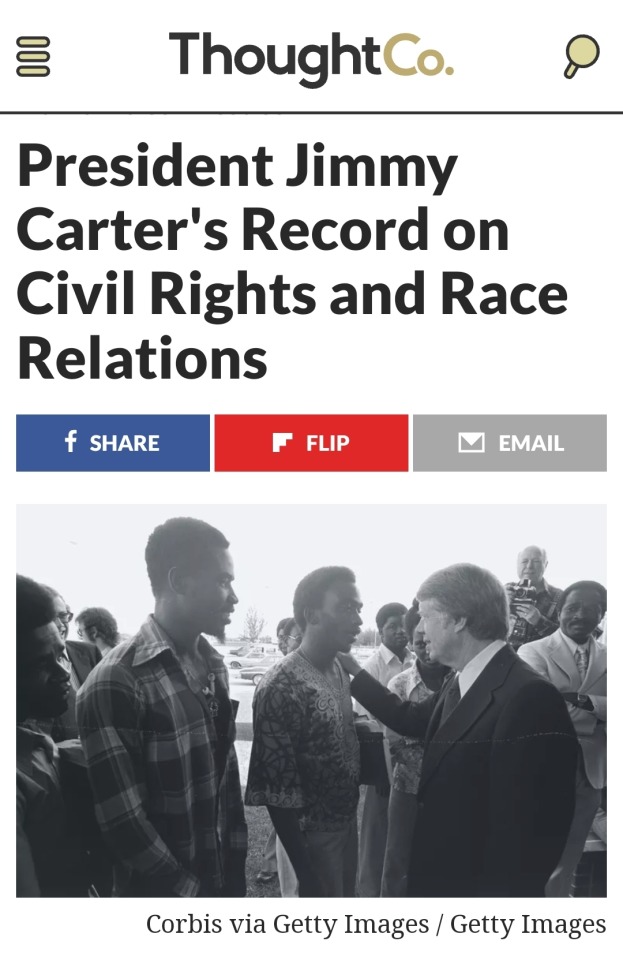
When Georgian Jimmy Carter won the 1976 presidential race, no politician from the Deep South had been elected since 1844. Despite Carter’s Dixie roots, the incoming president boasted a large Black fan base, having supported Black causes as a lawmaker in his home state. Four out of every five Black voters reportedly backed Carter and, decades later, when the country welcomed its first Black president, Carter continued to speak out about race relations in America. His record on civil rights before and after entering the White House reveal why Carter long garnered support from communities of color.
A Voting Rights Supporter
During his tenure as a Georgia state senator from 1963 to 1967, Carter worked to overturn laws that made it challenging for Black people to vote, according to the University of Virginia’s Miller Center. His pro-integration stance did not prevent him from serving two terms as state senator, but his views may have hurt his gubernatorial bid. When he ran for governor in 1966, an outpouring of segregationists turned out to the polls to elect Jim Crow supporter Lester Maddox. When Carter ran for governor four years later, he “minimized appearances before African American groups, and even sought the endorsements of avowed segregationists, a move that some critics call deeply hypocritical.” But Carter, it turned out, was simply being a politician.
When he became governor the following year, he announced that the time had come to end segregation. Clearly, he’d never supported Jim Crow but catered to segregationists just to win their votes.
Appointments of Black People in Key Positions
As Georgia governor, Carter didn’t just verbally oppose segregation but also worked to create more diversity in state politics. He reportedly raised the number of Black people on Georgia state boards and agencies from just three to a staggering 53. Under his leadership, almost half, 40 percent, of public servants in influential positions were Black.
Social Justice Platform Impresses Time, Rolling Stone
Gov. Carter’s views on civil rights so markedly differed from other Southern lawmakers, such as notorious Alabama Gov. George Wallace, that in 1971 he made the cover of Time magazine, which dubbed the Georgian the face of the “New South.” Just three years later, legendary Rolling Stone journalist, Hunter S. Thompson, became a fan of Carter after hearing the lawmaker discuss how politics can be used to effect social change.
A Racial Gaffe or More Duplicity?
Carter sparked controversy on April 3, 1976, while discussing public housing. The then-presidential candidate said that he thought community members should be able to preserve the “ethnic purity” of their neighborhoods, a statement that sounded like the tacit support of segregated housing. Five days later, Carter apologized for the comment. Had the pro-integrationist really meant to express support of Jim Crow housing, or was the statement just another ploy to get the segregationist vote?
Black College Initiative
As president, Carter launched the Black College Initiative to give historically Black colleges and universities more support from the federal government.
“Other administration education initiatives covered in the collection include science apprenticeships for minority students, technical assistance to Black colleges, and minority fellowships in graduate management education,” according to the “Civil Rights During the Carter Administration” report.
Business Opportunities for Black People
Carter also tried to close the wealth gap between whites and Black people. He developed initiatives to give Black-owned businesses a boost. “These programs focused primarily on increasing the government’s procurement of goods and services from minority business, as well as through requirements for procurement by federal contractors from minority firms,” the CRDTCA report states. “The aided industries ranged from construction to manufacturing to advertising, banking, and insurance. The government also maintained a program to help minority-owned exporters gain footholds in foreign markets.”
Affirmative Action Supporter
Affirmative action became a heavily debated topic when the U.S. Supreme Court heard the case of Allan Bakke, a white man denied admission to the medical school at the University of California, Davis. Bakke sued after UC Davis rejected him while admitting less qualified Black students, he argued. The case marked the first time affirmative action had been challenged so vigorously. Yet, Carter continued to support affirmative action, which endeared him to Black people.
Prominent Black people in the Carter Administration
When Carter became president, more than 4,300 Black people held elected office in the U.S. They also served in the Carter cabinet. “Wade H. Mc-Cree served as solicitor general, Clifford L. Alexander was the first Black secretary of the army, Mary Berry was the top official in Washington on educational matters prior to the establishment of the Department of Education, Eleanor Holmes Norton chaired the Equal Employment Opportunity Commission, and Franklin Delano Raines served on the White House staff,” according to the Spartacus-Educational website. Andrew Young, a Martin Luther King protégé and the first African American elected as a Georgia congressman since Reconstruction, served as U.S. ambassador to the United Nations. But Young’s outspoken views on race caused controversy for Carter and Young resigned under pressure. The president replaced with him another Black man, Donald F. McHenry.
Expansion from Civil Rights to Human Rights
When Carter lost his bid for re-election, he opened the Carter Center in Georgia in 1981. The institution promotes human rights across the world and has overseen elections in a number of countries and curbed human rights violations in places such as Ethiopia, Panama, and Haiti. The center has also focused on domestic issues, such as in October 1991, when it launched the Atlanta Project initiative to address urban social problems. In October 2002, President Carter won the Nobel Peace Prize for “his decades of untiring efforts to find peaceful solutions to international conflict.”
The Civil Rights Summit
Jimmy Carter was the first president to speak at the Lyndon B. Johnson Presidential Library Civil Rights Summit in April 2014. The summit commemorated the 50th anniversary of the groundbreaking Civil Rights Act of 1964. During the event, the former president urged the nation to do more civil rights work. “There’s still a gross disparity between Black and white people on education and employment,” he said. “A good amount of schools in the South are still segregated.” Given these factors, the civil rights movement isn’t just history, Carter explained but remains a pressing issue in the 21st century.
5 notes
·
View notes
Link
The Democrats’ draft spending bill still includes huge changes to the nation’s migration laws, even after the Senate’s parliamentarian removed several amnesties from the multi-trillion dollar spending bill.
The bill would dramatically push up housing prices by expanding the inflow of chain migrants, and also would slash white-collar salaries by creating a new and uncapped migration category of college-educated workers for a huge variety of Fortune 500 jobs from coast to coast.
Together, both migration rules will transfer wages and wealth from employees to coastal investors, and will also shift corporate investment, real estate wealth, government spending, and political power from heartland states — such as Ohio, Montana, West Virginia, and Arizona — to the major coastal states of California and New York.
But the parliamentarian’s decision to exclude the amnesties from the bill may prompt Democratic leaders to drop the uncapped white-collar giveaway for the Fortune 500 companies and their investors.
“If we’re talking about getting [white-collar] visas so we can take care of businesses’ problems, I’m not supportive — in the absence of getting anything else done,” Sen. Bob Menendez (D-NJ) told Bloomberg Government.
Sen. Dick Durbin (D-IL) also suggested that he might oppose the white-collar giveaway to the Fortune 500 if Democrats do not get their amnesties and new voters. “Bob [Menendez] and I have the same goal, which is to get as many people as possible on a path to citizenship,” he told Bloomberg.
However, Democrat leaders still want to turbocharge the chain migration process, even without the amnesties, Menendez indicated. “If we’re talking about recapturing visas for family backlogs … I certainly would consider that,” even without the amnesties, Menendez said.
For many years, Democrats have blocked business efforts to import more white-collar workers unless business leaders help them win more voters from amnesties. In January, for example, Menendez said, “we need the high-tech community who will benefit from the reforms we are proposing, to be an advocate of the overall [amnesty] reform movement.”
But “the chain migration [expansion] is something that is supported by the same left-wing activist community as the [excluded] amnesty, and so, as long as they get the chain migration, then the activist left will consider it a fair deal if the business community getting uncapped foreign workers,” former White House advisor Steven Miller told Breitbart News.
The underlying bargain– more cheap workers and consumers for the Fortune 500 in exchange for more poor voters for the Democrats — is cementing the strategic alliance between the progressives who run the Democratic Party and the corporate investors who run the Fortune 500, said Miller:
There’s a progressive-corporate alliance that has been forged inside of the Democratic Party and nowhere can it be seen more clearly than on migration and the current reconciliation bill. The progressive left wants unlimited chain migration and the corporate donors and lobbyists want uncapped foreign workers. The reconciliation bill delivers both. And if they’re also able to get an amnesty from the parliamentarian, which I fear they will be able to do in some form, then that will just further cement the alliance between powerful progressive and powerful corporations.
The Fortune 500 giveaway will allow companies to recruit an unlimited number of foreign graduates with dangled promises of green cards and citizenship, said Rob Law, the director of regulatory affairs and policy at the Center for Immigration Studies. “It will be the equivalent of having unlimited legal immigration for [foreign] college graduates,” he said.
The plan rewards the investor-run corporations that already use the green card workforce of at least one million imported H-1B, J-1, L-1, and OPT workers to drop white-collar salaries. The cheap and compliant workforce also excludes many outspoken American graduates from rewarding careers in healthcare, business, technology, design, or science.
Law continued:
These are the companies that have intentionally discriminated against American workers, have subjected American workers to training their unqualified foreign replacements as a condition of getting severance packages, and, and now it is going to be a permanent loop where they will have as many cheap foreign workers — with at least a college degree — as they want, and that will just further suppress wages.
Both of the huge immigration changes have been ignored by the establishment press, partly because their immigration reporters prefer to cover the fears and hopes of Haitians as they try to move from home in South America to jobs throughout the United States.
The proposed changes have been ignored by journalists even though they will damage the income and status of journalists — and of their friends and peers. With lower income and status, fewer journalists will be able to buy good homes and get their children into high-status universities.
The journalists have also failed to quiz critical swing-vote Democrats about the migration changes that would divert investments and jobs away from their homes states. So far, Sen. Joe Manchin (D-WV), Krysten Sinema (D-AZ), Sen. Mark Kelly (D-AZ), Sen. Jon Tester (D-MT), and Sen. Sherrod Brown (D-OH) have said little or nothing about the chain migration change or the white-collar indentured worker rule.
GOP leaders have also not challenged these proposed changes as violations of the Senate’s debating rules, even though both changes will damage GOP electoral support, and redirect wealth and political power from GOP-run states to Democrat-run coastal states.
GOP leaders have persuaded the Senate’s debate referee, the parliamentarian, to dismiss the Democrats’ proposed amnesties as policy changes disguised as budget changes. “The policy changes of this proposal far outweigh the budgetary impact scored to it and it is not appropriate for inclusion in reconciliation,” the parliamentarian wrote.
The amnesties are a direct threat to the jobs of GOP Senators because they would create many new Democratic voters.
But the silence about the chan migration plan and the white-collar giveaway reflects the reluctance of GOP legislators to protect Americans’ popular pocketbook interests amid donor demands for more migrants.
For example, on Wednesday, 34 House Republicans and 14 GOP Senators stayed silent as GOP leader Mitch McConnell approved a massive, expensive, and open-ended inflow of Afghans into Americans’ homes and jobs. The Senators were:
Roy Blunt (R-MO)
Richard Burr (R-NC)
Shelley Moore Capito (R-WV)
Bill Cassidy (R-LA)
Susan Collins (R-ME)
John Cornyn (R-TX)
Lindsey Graham (R-SC)
John Kennedy (R-LA)
Lisa Murkowski (R-AK)
Mitt Romney (R-UT)
Mike Rounds (R-SD)
Richard Shelby (R-AL)
Thom Tillis (R-NC)
Todd Young (R-IN)
In September, Breitbart News described the still;-hidden chain migration expansion in the spending bill:
The Democrats’ amnesty bill quietly invites three million chain migration arrivals into the U.S. workforce, likely forcing Americans to pay higher rents.
“It’s a huge deal,” said Jessica Vaughan, the director of policy studies at the Center for Immigration Studies.
About four million people are now waiting many years to get one of the roughly 240,000 cards annually available for the foreign siblings and adult children of legal immigrants. The new bill would allow them to “Early File’” for conditional residency and work permits if they have been waiting for more than two years and can also fly into the United States.
…
The amnesty’s offer of residency to the 3 million chain migration migrants likely could create an additional inflow of 1 million per year — and an extra shortfall of roughly 800,000 apartments or homes.
Many states’ residents are already suffering from high housing costs. For example, several low-income Americans and immigrants died in early September when a storm flooded their affordable basement apartments in New York.
Breitbart has also described the bill’s plan to flood the job market for U.S. graduates with a massive supply of foreign graduates who will work for low wages plus the promise of U.S. citizenship for themselves and their families:
Democrat leaders “are blowing away all the numerical limits” on employers offering green cards to [college graduate] employees, said Rosemary Jenks, policy director for NumbersUSA. “There’s no limit anywhere.”
The pending bill would allow U.S. investors and executives to import and pay an unlimited number of foreign workers with the dangled reward of citizenship. That citizenship-for-work law would minimize executives’ need to recruit Americans or even offer good salaries.
The bill was revealed Friday, and on Monday, was quickly rushed through the House judiciary committee without C-SPAN coverage. Mark Zuckerberg’s astroturf empire is marketing it as a relief bill for deserving illegal migrants — but it boosts investors by dramatically expanding the flow of cheap workers, government-funded consumers, and room-sharing renters into the U.S. economy. Democrat leaders hope to squeeze the bill through the Senate via the 50-vote reconciliation process.
The expanded foreign worker pipeline will remain open until at least September 2031, even though many millions of Americans will need jobs during the next ten years after they graduate with debts and degrees in health care, accounting, teaching, business, design, science, technology, or engineering. “If you’re in the pipeline by September 30, 2031, you’re in [the 2021 amnesty bill],” Jenks added.
The push for cheap workers and more chain migration is being led by Mark Zuckerberg’s FWD.us network of coastal investors. They stand to gain financially from more cheap labor, government-aided consumers, and urban renters.
Their network has funded many astroturf campaigns, urged Democrats to not talk about the economic impact of migration, and manipulated coverage by the TV networks and the print media.
Migration is deeply unpopular because it damages ordinary Americans’ career opportunities, cuts their wages, raises their rents, curbs their productivity, shrinks their political clout, widens regional wealth gaps, and wrecks their democratic, equality-promoting civic culture.
For many years, a wide variety of pollsters have shown deep and broad opposition to labor migration and the inflow of temporary contract workers into jobs sought by young U.S. graduates.
This pocketbook opposition is multiracial, cross-sex, non-racist, class-based, bipartisan, rational, persistent, and recognizes the solidarity Americans owe to each other.
2 notes
·
View notes
Text
NY / Night Scenes
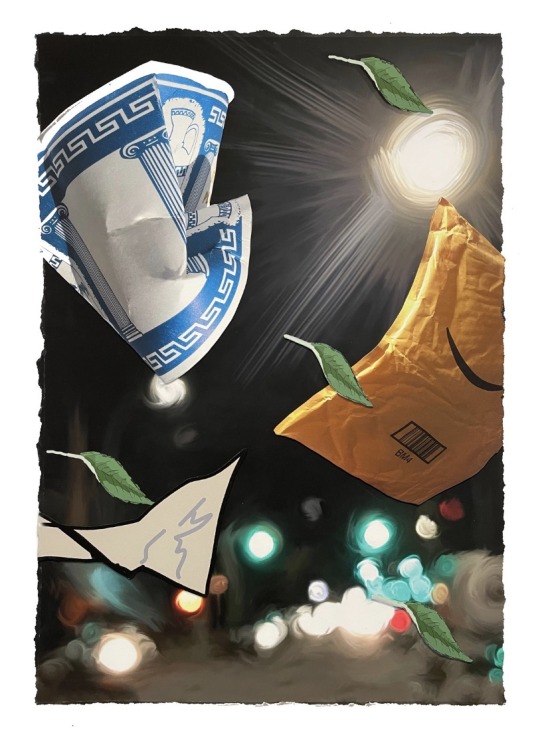
Ethan Greenbaum, Night Scene with Leaves, 2021, Inkjet Print, Acrylic Paint, Collage on Paper, 16.5” x 11.5”
Night Scenes
September 24 – October 24, 2021
The gallery will be open every Sat & Sun from 1 – 6pm and by appointment
Tiger Strikes Asteroid New York is pleased to present Night Scenes, a group exhibition curated by Sun You and Dominic Terlizzi. Featuring works by Richard Bosman, Ethan Greenbaum, Matt Jones, Christina Yuna Ko, Larysa Myers, Sarah Palmer, Alan Reid, Vanessa Gully Santiago, Ginevra Shay, Yuri Yuan and Monsieur Zohore.
During Covid lockdowns, I was taking a lot of walks at night. I became entranced with the city after dark—illuminated by artificial light and the melancholy, sexy energy of the nocturnal. I feel like now is a good time for a show featuring artists who work with themes of landscape, night, darkness and illumination.
ARTISTS
Richard Bosman is an Australian-American, born in Chennai, India who lives and works in Esopus, New York. He attended the Bryam Shaw School of Painting and Drawing, London, and the New York Studio School. His work has been shown at The British Museum, London; National Gallery of Australia, Canberra; Berggruen Gallery, San Francisco; Museum of Fine Arts, Boston; Brooke Alexander Gallery, New York; Freddy, Harris, NY; The Museum of Modern Art, New York; The Metropolitan Museum of Art, New York; Whitney Museum of American Art, New York; Brooklyn Museum, New York; Walker Art Center, Minneapolis; Museo Tamayo, Mexico City; and the 41st Venice Biennale, among others. Bosman is a recipient of a 1994 Guggenheim Fellowship.
Ethan Greenbaum is a New York based artist. Selected exhibition venues include KANSAS, New York; Derek Eller Gallery, New York; Hauser and Wirth, New York; Marlborough Chelsea, New York; Higher Pictures, New York; Marianne Boesky, New York; Circus Gallery, Los Angeles; Steve Turner, Los Angeles; The Suburban, Chicago; Michael Jon & Alan, Miami; The Aldrich Museum, Connecticut; Socrates Sculpture Park; Long Island City and Stems Gallery, Brussels. Recent projects include a solo presentation with Galerie Pact, Paris and solo exhibitions at Lyles & King, New York and Super Dakota, Brussels. His work has been discussed in The New York Times, Modern Painters, Artforum, BOMB Magazine, ArtReview and Interview Magazine, among others.
Matt Jones has had solo or two person shows at Galerie Jerome Pauchant, Paris; Freight + Volume Gallery, New York; Horton Gallery, Berlin; Castor Gallery, New York; The Richard Massey Foundation, New York; Bleecker Street Art Club, New York; and Buia Gallery, New York. He has participated in NADA, Miami; The Hole, New York; Spring Break Art Fair, Brooklyn; Driscoll Babcock, New York; Miami Project, and a solo presentation at Art Brussels, Bodson Gallery, Brussels. His work has been displayed in group shows at Robert Miller, New York; Anonymous, Mexico City; ADA Gallery, Richmond, Virginia; Galleri Geo, Bergen, Norway; and Fiebach Minninger, Cologne.
Christina Ko is a Korean American artist living and working in Queens, NY. She received her BFA from Cornell University in 2013, and has since then shown her work in Los Angeles, CA, Washington D.C., and in NYC. Selected exhibitions include: “In Good Taste”, Dinner Gallery, New York; “Futures Ever Arriving”, Chelsea Market, New York; “Internal Arrangements”, Trestle Gallery, Brooklyn, New York; “Downloading Place”, Wave Hill, Bronx, New York; “Fever Lure”, Selenas Mountain Gallery, Brooklyn, New York; “Crossover: East and West”, Korean Cultural Center, Washington D.C.. Her work has been featured in Gallery Gurls, the Arcade Project Zine, Hiss Magazine, The Fader magazine, The Washington Post, and Ballpit Magazine.
Larysa Myers studied drawing and painting at Grand Central Academy and textile design at Fashion Institute of Technology in New York City, developing a love for classical drawing methods and pattern making. After leaving the city and moving to Beacon, NY, she started a family and began a new body of work focusing on drawing. Her work has been featured in Maake Magazine, ArtMaze Mag, The Concern, and will be in an upcoming book by the Drawing Stall. She has shown her work at Mother Gallery in Beacon, and she participated in residencies at the Wassaic Project and Chashama.
Sarah Palmer was born in San Francisco and lives in Brooklyn. She received her BFA from Vassar College and MFA from the School of Visual Arts, in Photography, Video, and Related Media. She was awarded the 2011 Aperture Portfolio Prize and is represented by Mrs. Gallery in New York. Her work has been exhibited at the Foam_fotografiemuseum in Amsterdam (which holds her work in its permanent collection); NADA Miami with Mrs. Gallery (solo); SPRING/BREAK Art Show in New York; and, most recently, in the two-person exhibition Out of the Folds at Monti 8 in Latina, Italy, in summer 2020. Recent commissions include The New York Times, The New Yorker, and New Directions Press.
Alan Reid is a painter who was born in Texas and currently lives in Brooklyn. He has presented solo exhibitions at Lisa Cooley, New York; Mary Mary, Glassgow; A Palazzo, Brescia and Patricia Low, Gstaad. His monograph “Warm Equations” is published by Patrick Frey. He curated the exhibition Air de Pied a Terre, at Lisa Cooley, NY. Reid's work has been reviewed by Bomb, Frieze, Vogue, NYTimes, New Yorker, among others. He both writes and speaks about art, on occasion. Alan received an MFA at the Maryland Institute College of Art in Baltimore, MD in 2008, a BFA from the University of North Texas, Denton, TX, 2003 and attended the Summer Program at Yale University, New Haven, CT in 2001.
Vanessa Gully Santiago lives and works in Queens, NY and received her BFA from Cooper Union and MFA from Rutgers University. She has presented her work in solo exhibitions at James Fuentes Gallery, Thierry Goldberg Gallery, and American Medium Gallery, as well as in group and two person exhibits at Rachel Uffner Gallery, Mrs, Helena Anrather Gallery, JTT, Jack Barrett Gallery, Marinaro Gallery, Foxy Production, (all in New York); Smart Objects, in lieu (both in Los Angeles); Embajada Gallery (Puerto Rico), The Green Gallery (Milwaukee), C. Grimaldis Projects (Baltimore), and Rosenwald Wolf Gallery (Philadelphia), among others. She has been in residence at the Vermont Studio Center and Byrdcliffe Art Colony.
Ginevra Shay is based in NYC and Baltimore. They are a current MFA candidate at the Milton Avery School at Bard College. They have exhibited at Houston Center for Photography, Houston, TX; Museum Dhondt-Dhaenens, Sint-Martens-Latem, Belgium; PHROOM, Odessa, Ukraine; JEST, Turin, Italy; Center for Photography at Woodstock, Woodstock, NY; Maryland Institute College of Art, Baltimore, MD; Yale University Art Gallery, New Haven, CT; Institute of Contemporary Art, Philadelphia, PA; amidst many others. Their work resides in public collections including Yale University Art Gallery Library, Los Angeles County Museum of Art, International Center for Photography, Indie Photobook Library, Houston Center for Photography, and many others. They are a Maryland Individual Artist Award recipient for photography.
Yuri Yuan is a current Visual Arts MFA candidate at Columbia University, New York, NY. She received a BFA from the School of the Art Institute of Chicago, Chicago, IL in 2019. Yuan was a recipient of the Helen Frankenthaler Scholarship at Columbia University in 2020, and Elizabeth Greenshields Foundation Grant in 2019. She has exhibited work at Alexander Berggruen Gallery, New York City, NY; Make Room Gallery, Los Angeles, CA; The ROOM Contemporary Art Space, Venice, Italy; Lenfest Center for the Arts, New York, NY; Sullivan Galleries, Chicago, IL; Siragusa Gallery, Chicago, IL; International Center for the Arts, Umbria, Italy.
Monsieur Zohore is an Ivorian-American artist based in New York and Baltimore. Zohore received his BFA from the Cooper Union in 2015, and his MFA from the Maryland Institute College of Art in 2020. He is the Assistant Professor of Painting and Printmaking at VCU. Recently, he was the 2020 recipient of the WPA and Warhol Foundation Wherewithal Research Grant, and he has been awarded the Socrates Sculpture Park Fellowship for 2021. His work has been exhibited in various venues including Springsteen (Baltimore), Ethan Cohan (New York), Terrault Gallery (Baltimore), New Release Gallery (New York), 56 Henry (New York), Canada Gallery (New York), and Jack Barrett (New York) as well as at the 2020 Material Art Fair (Coyoacan, CMDX). Zohore has also been invited to show at The Baltimore Museum of Art (Baltimore), Washington Projects for the Arts (Washington D.C.), and at The Columbus Museum of Art (Columbus).

















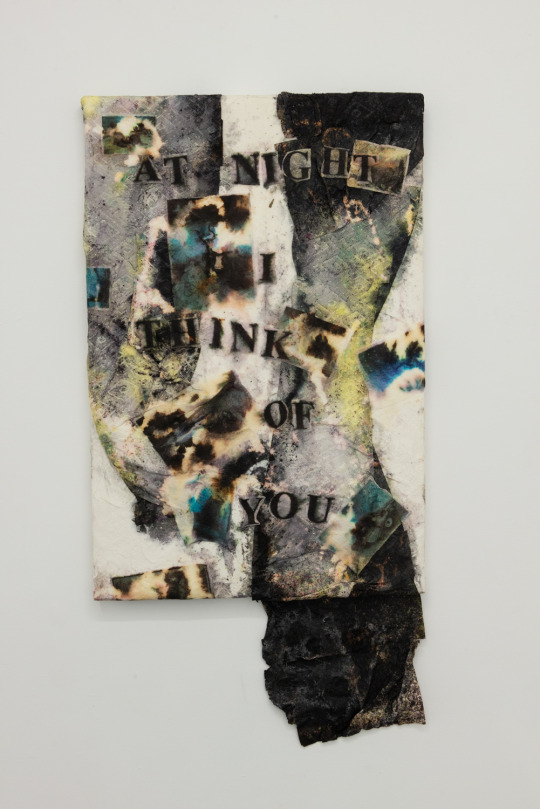




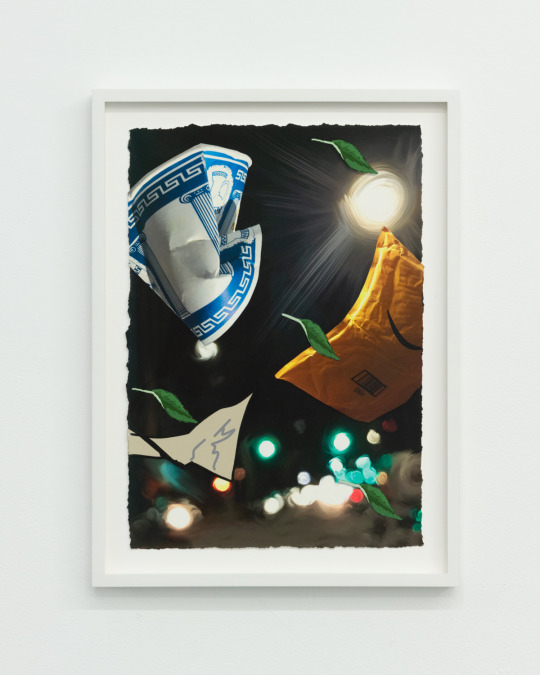



photos by Yael Eban
3 notes
·
View notes
Photo

Bonnie Louise Martin Trevillian of Lexington, formerly of Raleigh, passed away on Monday, January 24 at the home of her daughter where she had lived since the passing of her husband in May, 2021.
Bonnie was born in Bassett, Virginia in 1932 to John Wesley Martin and Lucy Doris Shelton Martin. She grew up in Bassett and attended the public schools there. After graduation from Bassett High School, she attended Bob Jones University in Greenville, SC.
In 1952, on a blind date arranged by a friend, she met her future husband, Al Trevillian, from Flint, Michigan. Thus began a 68-year romance that saw the birth of four children, 10 grandchildren and 11 great-grandchildren.
Much of Bonnie’s working life was spent doing bookkeeper-receptionist type work. In Raleigh, she worked for U.S. Floor Systems and the Life Enrichment Center. Her profession changed, however, when her needlework hobby led her to purchase a business called Threadbenders, located in the Glenwood Village shopping center. Bonnie also did a lot of volunteer work for Sanderson High School where her four children attended. She ran the concession stand at football games as a member of the band boosters and worked in the production of the program booklets used for the games. She was always busy with something.

Bonnie didn’t neglect her church, either. She put many hours into helping with the youth group of Millbrook Baptist Church, of which her children were a part. She remained dedicated to her faith throughout her life.
Bonnie was predeceased by her husband Al and her parents, as well as her three sisters, Dorothy Haynes, Helen Bryant and Rachel Miller. She is survived by her children, Bonnie Riddle (Steve), John Trevillian (Nancy), Jim Trevillian (Becky) and Robert Trevillian (Suzanne), as well as her grandchildren and great-grandchildren.
A graveside service will be held on Tuesday, February 1, 2022 at 2 p.m. at Brier Creek Memorial Gardens in Raleigh with The Reverend Allison Haynes officiating. There will be no formal viewing or visitation. Flowers are appreciated and memorials may be made to the American Heart Association in Bonnie’s name. Online condolences can be given to the family at www.jcgreenandsons.com.
#Bob Jones University#Archive#Obituary#BJU Hall of Fame#BJU Alumni Association#2022#Freshman#Class of 1950#Bonnie Louise Martin Trevillian
0 notes